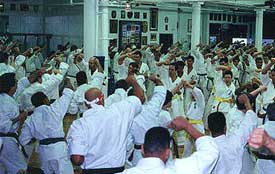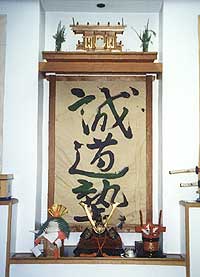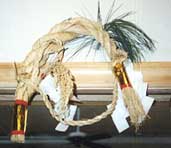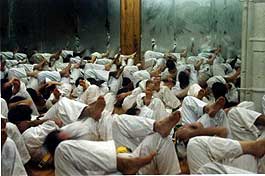Kagami Biraki: Renewing the Spirit
By Christopher Caile

Kagami Biraki, which literally means "Mirror
Opening" (also known as the "Rice Cutting
Ceremony"), is a traditional Japanese celebration
that is held in many traditional martial arts schools
(dojos) usually on the second Saturday or Sunday of
January so all students will be able to attend. (1)
It was an old samurai tradition dating back to the
15th century that was adopted into modern martial
arts starting in 1884 when Jigora Kano (the founder
of judo) instituted the custom at the Kodokan, his
organization's headquarters. (2)
Since then other Japanese arts, such as aikido, karate,
and jujutsu, have adopted the celebration that officially
kicks off the new year -- a tradition of renewal,
rededication and spirit.
In Japan Kagami Biraki is still practiced by many
families. It marks the end of the New Year's holiday
season which is by far the biggest celebration of
the year -- something which combines the celebration
of Christmas, the family orientation of Thanksgiving,
mixed with the excitement of vacation and travel.
It is a time when the whole nation (except for the
service industries) goes on holiday. It is also a
time for family and a return to traditional roots
-- prayers and offerings at the Shinto shrine and
Buddhist Temples, dress in kimonos, traditional food
and games. It is also a time when fathers are free
to relax and share with the family, to talk, play
games, eat and in more modern times, watch TV. It
is also a time for courtesy calls to business superiors
and associates as well as good customers. Work begins
about a week into the month, but parties with friends
and co-workers continue. (3)
In most traditional dojos preparation for the new
year's season begins as in most households. Toward
the end of the year dojos are cleaned, repairs made,
mirrors shined and everything made tidy. In Japan
many dojos retain the tradition of a purification
ceremony. Salt is thrown throughout the dojo, as salt
is a traditional symbol of purity (goodness and virtue),
(4) and then brushed away with pine boughs.
Decorations are then frequently placed around the
dojo. In old Japan they had great symbolism, but today
most people just think of them as traditional holiday
decorations.
 Stacked
rice cakes, often with an orange on top (representing
orchards) and other decorations, are placed on the
ceremonial center of the dojo, the shinzen. Called
Kagami Mochi, these rice cakes are rounded in the
shape of old fashioned metal mirrors and formed from
a hard dough of pounded rice. They symbolize full
and abundant good fortune. Their breaking apart (or
opening up) is the "Mirror Opening," after
which Kagami Biraki is named. Bits are then traditionally
consumed, often in a red bean soup. In modern days,
however, these rice cakes are often vinyl coated,
since homes and dojos are heated and food can easily
spoil. The coating stops the rice from getting moldy
and cracking due to heat and dryness. Thus in many
dojos these rice cakes are no longer consumed. (4) Stacked
rice cakes, often with an orange on top (representing
orchards) and other decorations, are placed on the
ceremonial center of the dojo, the shinzen. Called
Kagami Mochi, these rice cakes are rounded in the
shape of old fashioned metal mirrors and formed from
a hard dough of pounded rice. They symbolize full
and abundant good fortune. Their breaking apart (or
opening up) is the "Mirror Opening," after
which Kagami Biraki is named. Bits are then traditionally
consumed, often in a red bean soup. In modern days,
however, these rice cakes are often vinyl coated,
since homes and dojos are heated and food can easily
spoil. The coating stops the rice from getting moldy
and cracking due to heat and dryness. Thus in many
dojos these rice cakes are no longer consumed. (4)
 |
The dojo's spiritual center with holiday
decorations. At top the miniature shrine is
flanked with pine boughs set in vases. Below,
on the left, is a display of holiday rice-cakes
(Kagami Mochi). At middle is a replica of
a samurai armored helmet and at right a ceremonial
sake keg, another holiday symbol.
|
Other decorations are called kadomatsu,
which include bamboo (a symbol of uprightness and
growth), plum twigs (a symbol of spirit) and pine
boughs (from the mountains that are symbols of longevity).
Pine boughs are placed around the dojo, principally
on doors and in small vases to both sides of the kamidana
which is a miniature wooden Shinto shrine (usually
set on a shelf high on the ceremonial center). Pine
boughs are the only ornamentation not removed after
Kagami Biraki.
 |
Another decoration is Shimenawa which is
made of twisted strands of rice straw. It
is often found on the dojo's front door or
over the entrance to the dojo's practice floor.
This is a symbol of good luck and traditionally
it was believed it would help keep evil out.
|
For martial arts students today, however,
the New Year's celebration of Kigami Biraki has no
religious significance. It does, however, continue
the old samurai tradition of kicking off the new year.
It is also a time when participants engage in a common
endeavor and rededicate their spirit, effort and discipline
toward goals, such as training.
At our World Seido Karate Headquarters hundreds of
students congregate early in the morning to train
together, although it gets so crowded that real training
is difficult.  Practice
thus become more a sharing of spirit, as New Years
is expressed amongst the push-ups, kiais (shouts)
and many repetitions of technique. As effort and sweat
builds, a steamy mist rises among the participants.
There is also a message from our founder, Kaicho Tadashi
Nakamura, followed by short speeches by senior dojo
members. The celebration ends with refreshments (which
can be viewed as a symbolic representation of the
traditional rice cake breaking and consumption) and
a meeting of all teachers and Branch Chiefs. Practice
thus become more a sharing of spirit, as New Years
is expressed amongst the push-ups, kiais (shouts)
and many repetitions of technique. As effort and sweat
builds, a steamy mist rises among the participants.
There is also a message from our founder, Kaicho Tadashi
Nakamura, followed by short speeches by senior dojo
members. The celebration ends with refreshments (which
can be viewed as a symbolic representation of the
traditional rice cake breaking and consumption) and
a meeting of all teachers and Branch Chiefs.
In other schools the celebration is very different.
Ernie Estrada, Chief Instructor of Okinawan Shorin-ryu
Karate-do, reports that their Kagami Biraki is highlighted
by a special "Two Year Training." This includes
ten to twelve hours of intense training, the length
and severity symbolically representing the two year
time span.
George Donahue, a student of the late Kishaba Chokei
and Shinzato Katsuhiko, and former director of Matsubayashi
Ryu's Kishaba Juku of New York City, notes that in
Japan Kagami Baraki started with a long morning session
of zazen (kneeling meditation), and includes visits
to the dojo throughout the day by well-wishers, ex-students,
and local politicians. The day is ended with an especially
intense workout followed by a long party attended
by dojo members and honored guests from the community.
After three or four hours of speeches, toasts, eating,
and drinking, people demonstrate their kata. For non-local
students this is usually the only opportunity in the
year to receive a promotion.
For old style teachers who don't officially charge
for instruction, Kagami Biraki has special significance.
It is a day for students to anonymously honor their
teachers with cash gifts. Contributions are placed
within identical envelopes with no contributor identification,
and discreetly left in a pile for the teacher. (6)
The Ancient New Year's Observance
The Japanese New Year's tradition has its roots in
the ancient folk beliefs of agrarian China. If a bountiful
harvest was desired, it was thought necessary to first
create a warm, human atmosphere into which the harvest
would grow. Critical to this process were the bonds
of family and community based on blood, obligation
and work that were further strengthened during this
holiday from common celebration and sharing.
In Japan this tradition further evolved into a Shinto
celebration based primarily around the worship of
a deity Toshigama, (7) (thought to visit every household
in the new year) in order to insure the production
of the five gra`ins: rice, wheat barley, bean and
mullet.
In preparation for the deity's visit, people cleaned
and then decorated their homes to beautify them for
the diety. There were also prayers and ringing of
temple bells to ward off evil spirits. New Years was
initiated with visits to Shrines and family and ritual
ceremonies -- all revolving around Toshigama. While
today the meaning of most of these Shinto observances
has been forgotten, many of rituals remain in the
form of holiday traditions.
The symbolism of the mirror, which is central to
Kagami Biraki, dates back to the original trilogy
myth (along with the sword and the jewel) of the creation
of Japan. By the 15th century Shinto had interpreted
the mirror and sword to be important symbols of the
virtues that the nation should venerate. (8) They
also symbolized creation, legitimacy and authority
of the Emperor and by extension the samurai class
itself as part of the feudal system.
The mirror enabled people to see things as they are
(good or bad) and thus represented fairness or justice.
The mirror was also a symbol of the Sun Goddess --
a fierce spirit (the light face of god).
Swords had long been given spiritual qualities among
the samurai. And their possession contributed to a
sense of purpose and destiny inherent within the samurai
culture. So legendary were some swords that they were
thought to posses their own spirit (kami). (9)
Considered as one of the samurai's most important
possessions, the sword (and other weapons) symbolized
their status and position. Firm, sharp and decisive,
the sword was seen as a source of wisdom and venerated
for its power and lightning-like swiftness, but it
was also seen as a mild spirit (the dark face of god).
Taken together, the mirror and sword represent the
Chinese yin and yang, or two forms of energy permeating
everything -- the primeval forces of the universe
from which everything springs -- the source of spirit
empowering the Emperor by extension samurai class
who was in his service.
The Beginning of Kagami Biraki
It was from this time (15th century), it is said,
that the tradition of Kagami Biraki began. It developed
as a folk Shinto observation with a particular class
(samurai) bent. (10)
Before the New Year Kagami Mochi, or rice cakes,
were placed in front of the armory (11) to honor and
purify their weapons and armor. On the day of Kagami
Biraki the men of Samurai households would gather
to clean, shine and polish their weapons and armor
(12).
So powerful was the symbol of armor and weapons that
even today links to these feudal images remain. Japanese
households and martial arts dojos often display family
amor (family kami), helmets or swords, or modern replica,
displayed in places of honor. In front of these relics,
sticks of incense are burned to show honor and acknowledge
their heritage.
Women in samurai households also placed Kagami Mochi,
or rice cakes, in front of the family Shinto shrine.
A central element (set in front of the Shrine) was
a small round mirror made of polished silver, iron,
bronze or nickel. It was a symbol of the Sun Goddess,
but was also thought to embody the spirits of departed
ancestors. So strong was this belief that when a beloved
family member was near death, a small metal mirror
was often pressed close to the person's nostrils to
capture their spirit. (13)
The round rice cakes were thus used as an offering
-- in gratitude to the deities in the hope of receiving
divine blessing and also as an offering to family
spirits (and deceased family heroes). It was thought
that this offering would renew the souls of the departed
to which the family shrine was dedicated. (14)
To members of Japanese feudal society mirrors thus
represented the soul or conscience. Therefore it was
considered important to keep mirrors clean since it
was thought that mirrors reflected back on the viewer
his own thoughts. Thus the polishing of weapons and
amor on Kagami Biraki was symbolically (from mirror
polishing) seen as a method to clarify thought and
strengthen dedication to samurai's obligations and
duty in the coming year. Thus Kagami Biraki is also
known to some as "Armor Day."
This concept continues even today. When your karate,
judo or aikido teacher talks of self-polishing, of
working on and perfecting the self and to reduce ego,
the concept harkens back to the ancient concept of
mirror polishing to keep the mind and resolve clear.
On Kagami Baraki, the round rice cakes (often specially
colored to represent regions or clans) would be broken,
their round shape symbolizing a mirror and their breaking
apart symbolizing the mirror's opening. The cakes
were then consumed in a variety of ways.
The breaking of rice-cakes (Kagami Mochi) on Kagami
Biraki symbolizes the coming out (of a cave) of the
Sun Goddess in Japanese mythology, an act that renewed
light and spirit to the ancient world. (15). Thus
breaking apart the rice cakes each year on this date
represents a symbolic calling out again of this life
force and reenactment of the beginning (mythological)
of the world. (16)
The Kagami Mochi are consumed. This is seen as an
act of spiritual communion. It was believed that partaking
of these cakes not only symbolized the renewal of
the souls of their ancestors, but also the absorption
of the spirit (or aura) Toshigama (also probably the
Sun Goddess) to which the New Years season was dedicated.
For this reason eating Kagami Mochi has always represented
renewal, the start of the new year and the first breaking
of the earth or the preparation for coming agriculture.
Thus consumption was a physical act of prayer, happiness
and peace in the new year in the spirit of optimism,
renewal and good luck. The new year was thus seen
with hope, and full of fresh possibility, a clean
beginning and opportunity for dedication.
There were also very human benefits. The sharing
of rice cakes with family and clan members helped
strengthen common ties and bonds of allegiance and
friendship among warriors. Rice cakes also prepared
the body for the new year.
The new year holiday was most often filled with drinking,
celebration and eating ceremonial foods. On January
7, the body was first fortified with a special rice
herbal concoction that was thought to cure the body
of many diseases. Thus, by Kagami Biraki people's
bodies were ready for regulation and cleansing. Mocha
was often eaten with different edible grasses for
this purpose. It prepared people to resume a regular
schedule.
The very rice consumed itself had symbolic meaning
for the Samurai. Farmers once thought that rice having
breath (actually breathing in the ground), thus giving
rise to the concept of rice being "alive,"
(breathing in the field), and thus divine imbued with
a living deity (kami). On another level rice represented
the very economic backbone of the samurai society.
It was given to the samurai as a stipend in return
for service and allegiance to his lord (or alternatively
given control over land and peasants who produced
rice) -- in a society where wealth and power were
not based on currency, but on control of land which
produced agriculture.
In recent years some people have reinterpreted the
"Mirror Opening Ceremony" from a different
viewpoint, Zen. In the book, Angry White Pajamas -
An Oxford Poet Trains with the Tokyo Police, the author
Robert Twigger recounts as an interpretation of Kagami
Biraki an esoteric explanation given to him by someone
who had lived in a Zen monastery. The mirror, it was
explained, contains an old image, for what one sees
in the mirror is seen with old eyes. You see what
you expect to see, something that conforms with your
own self-image based on what you remember of yourself.
In this way the eyes connect people with their past
through the way they see their own image. This creates
a false continual. Instead every moment holds potential
for newness, another possibility for breaking with
the old pattern, the pattern being just a mental restraint,
something that binds us to the false self people call
"me." By breaking the mirror one breaks
the self-image that binds people to the past, so as
to experience the now, the present. "This is
Kagami Biraki," recounts Twigger, "a chance
to glimpse the reality we veil with mundaneness of
day-to-day living."
Also See:
About The Author
Christopher Caile, the founder and Editor-in-Chief
of FightingArts.com, is a historian, writer and researcher
on the martial arts and Japanese culture. A martial
artist for over 40 years he holds a 6th degree black
belt in karate and is experienced in judo, aikido,
daito-ryu, itto-ryu, boxing, and several Chinese arts.
He is also a teacher of qi gong.
Notes & Footnotes:
(1) Kagami Biraki officially falls on January 11
but dojos usually pay less attention to the specific
date preferring instead a date most convenient for
all dojo participants. Kagami Biraki also refers to
a traditional custom of breaking a sake (rice wine)
cask that is often done at ceremonies, receptions
and weddings.
(2) It is also known that Daito Ryu's Sokaku Takeda
also participated in Kagami Biraki in 1936, but the
tradition may have begun in his art much earlier.
(3) Originally, Kagami Biraki occurred on January
20th, but with the death of the third Shogun, Iemitsu,
in the Tokugawa shogunate, on January 20, 1651, it
was changed to the 11th, although some areas still
practice it on the 20th.
(4) In sumo matches the participants pick up salt
and scatter it over the wrestling circle. This is
also a purification ritual designed symbolically to
drive out evil spirits so the match will be fair and
honorable.
(5) In the home, in similar fashion to the dojo,
kagami-mochi (a pair of decorated rice cakes) are
placed on the family altar. While Kagami Mochi is
not traditionally eaten until the end of the holiday
season (Kagami Biraki), a variety of them are eaten
all through the new year's period. It was also once
customary (on Jan. 1) to drop bits of mocha down wells
as an offering to the water deity. On the 11th it
was also offered to the farmyard and crows. Outside
the home New Years decorations are also often hung,
and simple decorations (made of bamboo, or pine boughs
tied together with straw called kadomatsu) are displayed.
(6) This way the teacher has no way of knowing who
left what, thus making it impossible to curry favor
with a big donor. Many teachers still teach their
art for free.
(7) Toshigama, the New Years Gods, are believed to
be either, or both, the wife of Godu-Tennon or a chubby
old man who comes down from the mountains to bless
children.
(8) From the book, Mirror, Sword and Jewel - The
Geometry of Japanese Life, by Kurt Singer.
(9) Secrets Of The Samurai, Oscar Ratti, p. 255.
(10) Kagami Biraki is not a Shrine Shinto or Imperial
Shinto ceremony or tradition. It might be best classified
as "nenchu gyoji" which the Dictionary of
Japanese Ethnography defines as "traditional
observances repeated as a matter of custom in the
same manner and style at the same point in the annual
calendar." It notes that these observances are
usually undertaken by families, hamlets, ethnic bodies
or social groups, which give them the force of obligation,
and often appear at intersections of the agricultural
calendar.
To attempt to understand the ancient traditions,
we must try to put ourselves in the frame of mind
of the Japanese at that time. Their distance in time
from us is far outmeasured by the distance of worldly
perception. It was a time before science or understanding.
For most, life was a grueling existence fought out
in the vagaries of agricultural subsistence. Even
conscienceness had not risen to a sense of self-concept,
man's sense of self instead inextricable intertwined
in the web of land, family and society of feudal life.
All the forces of nature buffeted this island grouping
and great natural mysteries confronted their existence.
What was one to make of storms, rain, snow, wind and
lightening? What was the sun, moon, stars, and why
did seasons change? How could you understand sickness,
even death that was as surly a companion in life as
one's shadow. Caught in this vortex of uncertainty,
life seemed imbued with unseen forces and energies,
as gods and spirits seemed to direct forces and nature
-- man's influence limited to ritual, magic and attempts
to influence these greater forces.
(11) Information provided by John Nelson, author
of A Year in the Life of a Shinto Shrine, and Professor
in the Religious Studies Program at the University
of San Francisco.
(12) Information given to the author by Bryan McCarthy,
a martial artist, Japanese translator, and Ph.D. student
in humanistic studies with a research specialty in
Japan, at the State University of New York at Albany.
(13) The mirror was then wrapped in silk and placed
in a box inscribed with the name of the ancestor.
They were held in such high respect and honor that
they were never allowed on the floor, and it was considered
a serious crime (in feudal times) to step over them.
(14) Since animals and even farming tools were thought
to receive the new year, often special colored rice
cakes were prepared and placed in the middle of the
family living room.
Rice cakes or mocha are Japan's oldest food that
hearken back to pre-medieval times and represent Shinto's
spirit food, as it is said that round rice cakes were
once used as an archery target, and once when an arrow
pierced a cake a white bird flew out. It was often
eaten as a restorative. During new years Kigali Mocha
are all purpose offerings. In January first bits of
rice cakes were once dropped down wells as an offering
to water gods. On the eleventh, samurai farmers also
offered cakes to farm yard animals. On the fifteenth,
known as "Little New Years," was when families
partake them alone in hearty stews. When consuming
mochi it was thought to be good luck to stretch mochi
with chopsticks as you bit into it -- the longer the
stretch, it was thought, the longer the life.
(15) From Dr. Ryuichi Abe, a professor of Religion
at Colombia University.
(16) When the Sun Goddess, Amaterasu-omikami hid
in a cave and the world became dark, a mirror was
taken out and everyone prayed to the mirror (which
symbolized the Sun Goddess) that she would reveal
herself again. The prayers were successful and the
world became bright and happy again by her reappearance.
Kagami Mochi are made in the shape of a mirror to
represent the mirror used in the time of the Sun Goddesses
hiding in the cave. Thus the offering of these rice
cakes symbolize a prayer for a brighter, happier and
renewed life.

back
to top
home
| about
us | magazine
| learning
| connections
| estore
|